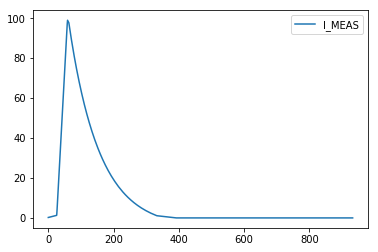Dear SWAN Users,
I am writing to share with you a package developed for simplifying query and processing of signals from Post Mortem, CALS, and NXCALS databases. The package was created as a part of the Signal Monitoring project I am involved in. The goal of this entry is to share the package with other users as some of you may find it useful in daily work.
The entry is an excerpt from API documentation also available as a SWAN notebook.
1. Logging Database Overview
Naturally, one should use a general purpose browser for ad-hoc queries and exploration for signal hierarchy:
- The new PM web browser is available at the following link: http://post-mortem-paas.web.cern.ch/
- The new TIMBER NXCALS web browser is available at: https://timber.cern.ch/
- In order to find the mapping between CALS variables and NXCALS variable and metadata (along with the data migration status), please consult: https://ccde.cern.ch/dataBrowser/search?acwReportName=CALS-to-NXCALS%20Data%20Migration&domainName=CALS
In order to programatically query PM, CALS, or NXCALS database, a dedicated API along with parameters is required. An overview of databases from query perspective is summarised in the table below.
| PM | PM | CALS | CALS* | NXCALS | NXCALS | |
|---|---|---|---|---|---|---|
| query type | event | signal | signal | feature | signal | feature |
| input | system, source, className | system, source, className, signal | signal | signal, features | system, (device, property), signal | system, (device, property), signal, features |
| time definition | time range | timestamp | time range | time range | time range | time range |
| time unit | ns | ns | s | s | ns | ns |
| return type | json | json | dict of list | dict of list | spark dataframe | spark dataframe |
| execution time | fast | fast | can be slow | fast | slow | fast |
| execution type | serial | serial | serial | ? | serial | parallel |
| use | simple | simple | simple | simple | simple | requires good knowledge of pyspark |
*The pytimber package provides an access to feature queries (for more details, please consult GitHub - rdemaria/pytimber: Python Wrapping of CALS API). Since CALS is about to be discontinued, we decided not to support this query in favor of NXCALS.
The native API for each database is available at:
- PM REST API: http://pm-api-pro/
- pytimber CALS API: GitHub - rdemaria/pytimber: Python Wrapping of CALS API
- NXCALS python API: http://nxcals-docs.web.cern.ch/0.4.11/
2. Use of Native API to Query Signals in Python
- Post Mortem REST API
import pandas as pd
import requests
import json
response = requests.get('http://pm-api-pro/v2/pmdata/signal?system=FGC&className=51_self_pmd&source=RPTE.UA47.RB.A45×tampInNanos=1426220469520000000&signal=STATUS.I_MEAS')
json_response = json.loads(response.text)
name = json_response['content'][0]['namesAndValues'][0]['name']
time = json_response['content'][0]['namesAndValues'][1]['value']
value = json_response['content'][0]['namesAndValues'][0]['value']
pd.DataFrame(value, time, [name]).plot()
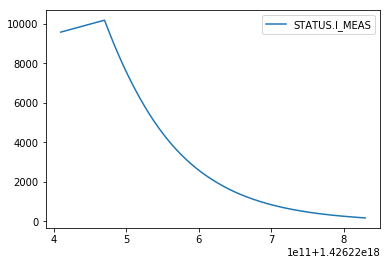
Note that for other systems the structure of returned json file may differ and requires dedicated handling
- CALS pytimber API
import pandas as pd
import pytimber
ldb = pytimber.LoggingDB()
i_meas = ldb.get("RPTE.UA47.RB.A45:I_MEAS", '2015-03-13 05:20:49.4910002', '2015-03-13 05:22:49.4910002')
pd.DataFrame(i_meas.get("RPTE.UA47.RB.A45:I_MEAS")[1], i_meas.get("RPTE.UA47.RB.A45:I_MEAS")[0], ["RPTE.UA47.RB.A45:I_MEAS"]).plot()
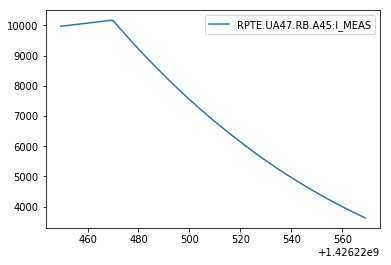
- NXCALS API
from cern.nxcals.pyquery.builders import *
import pandas as pd
i_meas_df = DevicePropertyQuery.builder(spark).system('CMW') \
.startTime(pd.Timestamp('2015-03-13T04:20:59.491000000').to_datetime64())\
.endTime(pd.Timestamp('2015-03-13T04:22:49.491000000')) \
.entity().device('RPTE.UA47.RB.A45').property('SUB') \
.buildDataset().select('acqStamp', 'I_MEAS').dropna().sort("acqStamp").toPandas()
i_meas_df.set_index(i_meas_df['acqStamp'], inplace=True)
i_meas_df.drop(columns='acqStamp', inplace=True)
i_meas_df.plot()
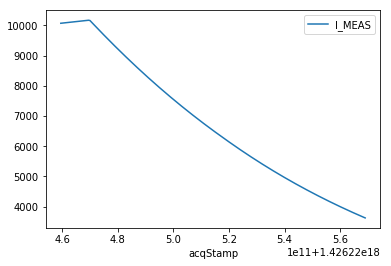
Note that signal query with NXCALS is quite time consuming.
3. pyeDSL - Embedded Domain Specific Language in Python
Use of the native API in larger analyses requires a lot of code and is difficult to generalise and introduce a structure for repeatable queries. Natural languages have certain structure [1].
| Language | Word order | Example |
|---|---|---|
| English: | {Subject}.{Verb}.{Object}: | John ate cake |
| Japanese: | {Subject}.{Object}.{Verb}: | John-ga keiki-o tabeta |
| - | - | John cake ate |
One can enforce syntactical order in code:
- Domain Specific Language – new language, requires a parser
- Embedded Domain Specific Language – extends existing language
Furthermore, an eDSL could be implemented following the Fluent interface approach [2]. The use of an eDSL for signal query and processing is not a new concept as there exists already an eDSL in Java used to automatically check signals during Hardware Commisionning campaigns of the LHC [3].
[1] K. Gulordava, Word order variation and dependency length minimisation: a cross-linguistic computational approach, PhD thesis, UniGe,
[2] Fluent interface - Wikipedia
[3] M. Audrain, et al. - Using a Java Embedded Domain-Specific Language for LHC Test Analysis, ICALEPCS2013, San Francisco, CA, USA
3.1. QueryBuilder
We propose a python embedded Domain Specific Language (pyeDSL) for building queries:
- General purpose query
e.g.
df = QueryBuilder().{with_pm()/with_cals()/with_nxcals()}.with_duration().with_query_parameters()\
.signal_query().dfs[0]
df = QueryBuilder().{with_pm()/with_cals()/with_nxcals()}.with_timestamp().with_query_parameters()\
.signal_query().dfs[0]
- Circuit-oriented query to generalize query across and within circuit types
e.g.
df = QueryBuilder().{with_pm()/with_cals()/with_nxcals()}.with_duration().with_circuit_type().with_metadata()\
.signal_query().dfs[0]
df = QueryBuilder().{with_pm()/with_cals()/with_nxcals()}.with_timestamp().with_circuit_type().with_metadata()\
.signal_query().dfs[0]
With this approach:
- each parameter defined once (validation of input at each stage)
- single local variable is required
- order of operation is fixed
- vector inputs are supported
Furthermore, the pyeDSL provides hints on the order of execution
from lhcsmapi.pyedsl.QueryBuilder import QueryBuilder
QueryBuilder()
Set database name using with_pm(), with_cals(ldb), with_nxcals(spark) method.
from lhcsmapi.pyedsl.QueryBuilder import QueryBuilder
QueryBuilder().with_nxcals(spark)
Database name properly set to NXCALS. Set time definition: for PM signal query, with_timestamp(),
for PM event query or CALS, NXCALS signal query, with_duration()
from lhcsmapi.pyedsl.QueryBuilder import QueryBuilder
QueryBuilder().with_nxcals(spark).with_duration(t_start='2015-03-13 05:20:59.4910002', duration=[(100, 's'), (100, 's')])
Query duration set to t_start=1426220359491000200, t_end=1426220559491000200. Set generic query parameter using with_query_parameters() method, or a circuit signal using with_circuit_type() method.
At the same time it prohibits unsupported operations throwing a meaningful exception.
from lhcsmapi.pyedsl.QueryBuilder import QueryBuilder
QueryBuilder().with_duration(t_start='2015-03-13 05:20:59.4910002', duration=[(100, 's'), (100, 's')])
AttributeError: with_duration() is not supported. Set database name using with_pm(), with_cals(ldb), with_nxcals(spark) method.
A sentence constructed this way maintains the differences of query types while providing a common structure.
3.1.1. PM Event Query
Allows finding source and timestamp of PM events within a period of time.
from lhcsmapi.pyedsl.QueryBuilder import QueryBuilder
source_timestamp_df = QueryBuilder().with_pm() \
.with_duration(t_start='2015-03-13 05:20:59.4910002', duration=[(100, 's'), (100, 's')]) \
.with_query_parameters(system='FGC', className='51_self_pmd', source='RPTE.UA47.RB.A45') \
.event_query().df
source_timestamp_df
| source | timestamp | |
|---|---|---|
| 0 | RPTE.UA47.RB.A45 | 1426220469520000000 |
3.1.2. PM Signal Query
Queries signal based on a timestamp as well as system, source, className, and signal.
from lhcsmapi.pyedsl.QueryBuilder import QueryBuilder
i_meas_df = QueryBuilder().with_pm() \
.with_timestamp(1426220469520000000) \
.with_query_parameters(system='FGC', source='RPTE.UA47.RB.A45', className='51_self_pmd', signal='STATUS.I_MEAS') \
.signal_query().dfs[0]
i_meas_df.plot()

3.1.3. CALS Signal Query
Queries signal based on a time duration as well as signal.
from lhcsmapi.pyedsl.QueryBuilder import QueryBuilder
import pytimber
ldb = pytimber.LoggingDB()
i_meas_df = QueryBuilder().with_cals(ldb) \
.with_duration(t_start='2015-03-13 05:20:59.4910002', duration=[(100, 's'), (100, 's')]) \
.with_query_parameters(signal='RPTE.UA47.RB.A45:I_MEAS') \
.signal_query().dfs[0]
i_meas_df.plot()
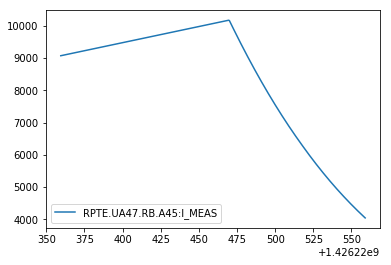
3.1.4. NXCALS Signal Query
Queries signal based on a time duration as well as system, device, property, and signal.
from lhcsmapi.pyedsl.QueryBuilder import QueryBuilder
i_meas_df = QueryBuilder().with_nxcals(spark) \
.with_duration(t_start='2015-03-13 05:20:59.4910002', duration=[(100, 's'), (100, 's')]) \
.with_query_parameters(nxcals_system='CMW', nxcals_device='RPTE.UA47.RB.A45', nxcals_property='SUB', signal='I_MEAS') \
.signal_query().dfs[0]
i_meas_df.plot()
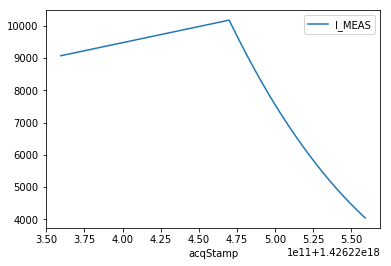
Queries signal based on a time duration as well as system and signal.
from lhcsmapi.pyedsl.QueryBuilder import QueryBuilder
u_mag_df = QueryBuilder().with_nxcals(spark) \
.with_duration(t_start='2015-03-13 05:20:59.4910002', duration=[(100, 's'), (100, 's')]) \
.with_query_parameters(nxcals_system='WINCCOA', signal='DCBA.15R4.R:U_MAG') \
.signal_query().dfs[0]
u_mag_df.plot()
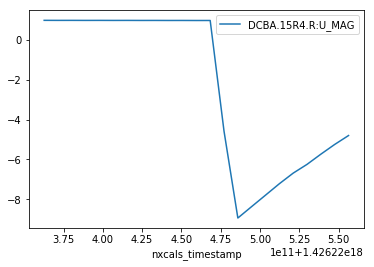
3.1.5. NXCALS Feature Query
Queries signal features (mean, std, max, min, count) based on a time duration as well as system, device, property, and signal.
from lhcsmapi.pyedsl.QueryBuilder import QueryBuilder
i_meas_df = QueryBuilder().with_nxcals(spark) \
.with_duration(t_start=1526898157236000000, t_end=1526903352338000000) \
.with_query_parameters(nxcals_system='CMW', nxcals_device='RPTE.UA23.RB.A12', nxcals_property='SUB', signal='I_MEAS') \
.feature_query(['mean', 'std', 'max', 'min', 'count']).df
i_meas_df
| device | max | min | count | mean | std | |
|---|---|---|---|---|---|---|
| 0 | RPTE.UA23.RB.A12 | 10978.8 | 757.18 | 2498 | 5374.768659 | 3315.972856 |
The same query with native NXCALS API is
i_meas_results_ds = DevicePropertyQuery.builder(spark).system('CMW') \
.startTime(t_start_injs).endTime(t_end_sbs) \
.entity().device('RPTE.UA23.RB.A12').property('SUB') \
.buildDataset().select("acqStamp", 'I_MEAS', "device") \
.agg(func.mean('I_MEAS'), func.stddev('I_MEAS'), func.max('I_MEAS'),
func.min('I_MEAS'), func.count('I_MEAS')).collect()
i_meas_results_df = pd.DataFrame(i_meas_results_ds, columns=['I_MEAS_device', 'I_MEAS_class', 'I_MEAS_mean', 'I_MEAS_std', 'I_MEAS_max', 'I_MEAS_min', 'I_MEAS_count']).sort_values(by=['I_MEAS_class'])
i_meas_results_df
Queries signal features (mean, std, max, min, count) based on a time duration as well as system and signal.
from lhcsmapi.pyedsl.QueryBuilder import QueryBuilder
u_mag_df = QueryBuilder().with_nxcals(spark) \
.with_duration(t_start=1526898157236000000, t_end=1526903352338000000) \
.with_query_parameters(nxcals_system='WINCCOA', signal='DCBB.8L2.R:U_MAG') \
.feature_query(['mean', 'std', 'max', 'min', 'count']).df
u_mag_df
| nxcals_variable_name | max | min | count | mean | std | |
|---|---|---|---|---|---|---|
| 0 | DCBB.8L2.R:U_MAG | 0.002113 | -0.975332 | 51951 | -0.196706 | 0.375195 |
3.2. Polymorphism
pyeDSL allows for processing of lists of signal definitions.
- multiple signal, mutliple sources, multiple systems, multiple className
from lhcsmapi.pyedsl.QueryBuilder import QueryBuilder
i_meas_df = QueryBuilder().with_pm() \
.with_timestamp(1426220469520000000) \
.with_query_parameters(system=['FGC', 'FGC'], source=['RPTE.UA47.RB.A45', 'RPTE.UA47.RB.A45'],
className=['51_self_pmd', '51_self_pmd'], signal=['STATUS.I_MEAS', 'STATUS.I_REF']) \
.signal_query().dfs
ax=i_meas_df[0].plot()
i_meas_df[1].plot(ax=ax)
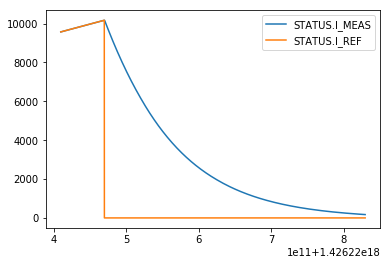
- multiple signal, single source, single system, single className
from lhcsmapi.pyedsl.QueryBuilder import QueryBuilder
i_meas_df = QueryBuilder().with_pm() \
.with_timestamp(1426220469520000000) \
.with_query_parameters(system='FGC', source='RPTE.UA47.RB.A45',
className='51_self_pmd', signal=['STATUS.I_MEAS', 'STATUS.I_REF']) \
.signal_query().dfs
ax=i_meas_df[0].plot()
i_meas_df[1].plot(ax=ax)

3.3. Advanced Feature Query
NXCALS enables calculation of signal features such as min, max, mean, std, count directly on the cluster without the need for costly query of the signal and performing calculation locally. This approach enables parallel computing on the cluster. To this end, a query should contain an element enabling a group by operation. Each group by operation allows for executing computation in parallel.
- Feature query of multiple signals for the same period of time
from lhcsmapi.pyedsl.QueryBuilder import QueryBuilder
i_meas_df = QueryBuilder().with_nxcals(spark) \
.with_duration(t_start=1526898157236000000, t_end=1526903352338000000) \
.with_circuit_type('RB') \
.with_metadata(circuit_name='*', system='PC', signal='I_MEAS') \
.feature_query(['mean', 'std', 'max', 'min', 'count']).df
i_meas_df
| device | max | min | count | mean | std | |
|---|---|---|---|---|---|---|
| 0 | RPTE.UA63.RB.A56 | 10974.36 | 756.90 | 2498 | 5372.636369 | 3314.646638 |
| 1 | RPTE.UA87.RB.A81 | 10973.21 | 756.82 | 2498 | 5371.596990 | 3314.230379 |
| 2 | RPTE.UA83.RB.A78 | 10967.94 | 756.47 | 2498 | 5369.226934 | 3312.676833 |
| 3 | RPTE.UA27.RB.A23 | 10976.46 | 757.04 | 2498 | 5373.973151 | 3315.324716 |
| 4 | RPTE.UA43.RB.A34 | 10975.16 | 756.95 | 2497 | 5373.559131 | 3314.074552 |
| 5 | RPTE.UA67.RB.A67 | 10978.56 | 757.18 | 2498 | 5374.329179 | 3315.855302 |
| 6 | RPTE.UA47.RB.A45 | 10971.44 | 756.71 | 2497 | 5370.954557 | 3312.837184 |
| 7 | RPTE.UA23.RB.A12 | 10978.80 | 757.18 | 2498 | 5374.768659 | 3315.972856 |
- Feature query of multiple signals with the same period of time subdivided into three intervals - group by signal name and interval
t_start_injs = 1526898157236000000
t_end_injs = 1526899957236000000
t_start_sbs = 1526901552338000000
t_end_sbs = 1526903352338000000
from lhcsmapi.pyedsl.QueryBuilder import QueryBuilder
i_meas_df = QueryBuilder().with_nxcals(spark) \
.with_duration(t_start=t_start_injs, t_end=t_end_sbs) \
.with_circuit_type('RB') \
.with_metadata(circuit_name='RB.A12', system='PC', signal='I_MEAS')\
.signal_query().dfs[0]
ax = i_meas_df.plot(figsize=(10,5), linewidth=5)
ax.axvspan(xmin=t_start_injs, xmax=t_end_injs, facecolor='xkcd:goldenrod')
ax.axvspan(xmin=t_end_injs, xmax=t_start_sbs, facecolor='xkcd:grey')
ax.axvspan(xmin=t_start_sbs, xmax=t_end_sbs, facecolor='xkcd:green')
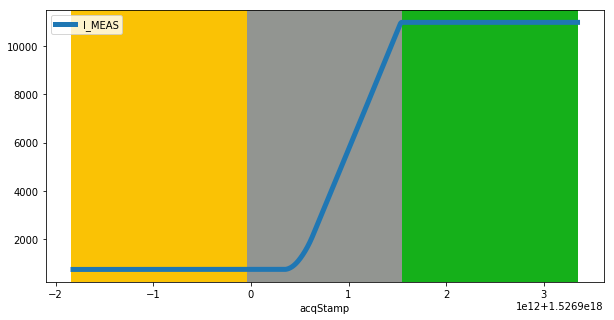
Function translate introduces a mapping based on the time column. Here, we consider three subintervals for beam injection, beam acceleration, and stable beams.
As a result, the time column forms a partition and can be executed in parallel.
from pyspark.sql.functions import udf
from pyspark.sql.types import IntegerType
def translate(timestamp):
if(timestamp >= t_start_injs and timestamp < t_end_injs):
return 1
if(timestamp >= t_end_injs and timestamp < t_start_sbs):
return 2
if(timestamp >= t_start_sbs and timestamp <= t_end_sbs):
return 3
return -1
translate_udf = udf(translate, IntegerType())
The translate function should be passed as a function argument
i_meas_df = QueryBuilder().with_nxcals(spark) \
.with_duration(t_start=t_start_injs, t_end=t_end_sbs) \
.with_circuit_type('RB') \
.with_metadata(circuit_name='*', system='PC', signal='I_MEAS') \
.feature_query(['mean', 'std', 'max', 'min', 'count'], function=translate_udf).df
i_meas_df.head()
| device | class | max | min | count | mean | std | |
|---|---|---|---|---|---|---|---|
| 0 | RPTE.UA43.RB.A34 | 1 | 756.96 | 756.95 | 60 | 756.959833 | 0.001291 |
| 1 | RPTE.UA63.RB.A56 | 3 | 10974.36 | 10974.35 | 60 | 10974.350167 | 0.001291 |
| 2 | RPTE.UA47.RB.A45 | 3 | 10971.44 | 10971.43 | 60 | 10971.439667 | 0.001810 |
| 3 | RPTE.UA47.RB.A45 | 2 | 10970.89 | 756.71 | 2377 | 5346.059971 | 3193.562789 |
The same method applied to NXCALS signals based on variable
from lhcsmapi.pyedsl.QueryBuilder import QueryBuilder
u_mag_ab_df = QueryBuilder().with_nxcals(spark) \
.with_duration(t_start=t_start_injs, t_end=t_end_sbs) \
.with_circuit_type('RB') \
.with_metadata(circuit_name='RB.A12', system='BUSBAR', signal='U_MAG', wildcard={'BUSBAR': 'DCBB.8L2.R'}) \
.feature_query(['mean', 'std', 'max', 'min', 'count'], function=translate_udf).df
u_mag_ab_df
| nxcals_variable_name | class | max | min | count | mean | std | |
|---|---|---|---|---|---|---|---|
| 0 | DCBB.8L2.R:U_MAG | 3 | 0.002003 | -0.034035 | 18000 | -0.001983 | 0.002882 |
| 1 | DCBB.8L2.R:U_MAG | 1 | 0.002113 | -0.005992 | 18000 | -0.001861 | 0.002844 |
| 2 | DCBB.8L2.R:U_MAG | 2 | 0.002041 | -0.975332 | 15951 | -0.636315 | 0.423767 |
This method can be used together with signal decimation, i.e., taking every nth sample.
For example this can be useful to query QPS board A and B which share the same channel and samples are shifted by 5 so that
- every 10-th sample belongs to board A (or B), decimation=10
from lhcsmapi.pyedsl.QueryBuilder import QueryBuilder
u_mag_a_df = QueryBuilder().with_nxcals(spark) \
.with_duration(t_start=t_start_injs, t_end=t_end_sbs) \
.with_circuit_type('RB') \
.with_metadata(circuit_name='RB.A12', system='BUSBAR', signal='U_MAG', wildcard={'BUSBAR': 'DCBB.8L2.R'}) \
.feature_query(['mean', 'std', 'max', 'min', 'count'], function=translate_udf, decimation=10).df
u_mag_a_df
| nxcals_variable_name | class | max | min | count | mean | std | |
|---|---|---|---|---|---|---|---|
| 0 | DCBB.8L2.R:U_MAG | 3 | 0.002003 | -0.012705 | 1800 | 0.000812 | 0.000529 |
| 1 | DCBB.8L2.R:U_MAG | 1 | 0.002113 | -0.000463 | 1800 | 0.000965 | 0.000434 |
| 2 | DCBB.8L2.R:U_MAG | 2 | 0.002041 | -0.969405 | 1595 | -0.633601 | 0.423847 |
- every 5+10-th sample belongs to board B (or A), decimation=10, shift=5
from lhcsmapi.pyedsl.QueryBuilder import QueryBuilder
u_mag_b_df = QueryBuilder().with_nxcals(spark) \
.with_duration(t_start=t_start_injs, t_end=t_end_sbs) \
.with_circuit_type('RB') \
.with_metadata(circuit_name='RB.A12', system='BUSBAR', signal='U_MAG', wildcard={'BUSBAR': 'DCBB.8L2.R'}) \
.feature_query(['mean', 'std', 'max', 'min', 'count'], function=translate_udf, decimation=10, shift=5).df
u_mag_b_df
| nxcals_variable_name | class | max | min | count | mean | std | |
|---|---|---|---|---|---|---|---|
| 0 | DCBB.8L2.R:U_MAG | 3 | -0.003425 | -0.034035 | 1800 | -0.004754 | 0.000877 |
| 1 | DCBB.8L2.R:U_MAG | 1 | -0.003361 | -0.005992 | 1800 | -0.004656 | 0.000441 |
| 2 | DCBB.8L2.R:U_MAG | 2 | -0.003052 | -0.975332 | 1595 | -0.639233 | 0.423941 |
- with polymorphism one can query 1248 busbar at once (in two batches of 624 due to the limit of 1000 signal per query)
from lhcsmapi.pyedsl.QueryBuilder import QueryBuilder
u_mag_ab_df = QueryBuilder().with_nxcals(spark) \
.with_duration(t_start=t_start_injs, t_end=t_end_sbs) \
.with_circuit_type('RB') \
.with_metadata(circuit_name='*', system='BUSBAR', signal='U_MAG', wildcard={'BUSBAR': '*'}) \
.feature_query(['mean', 'std', 'max', 'min', 'count'], function=translate_udf).df
u_mag_ab_df.head()
| nxcals_variable_name | class | max | min | count | mean | std | |
|---|---|---|---|---|---|---|---|
| 0 | DCBA.22L4.L:U_MAG | 1 | -0.000167 | -0.002102 | 18000 | -0.001110 | 0.000639 |
| 1 | DCBA.14L4.R:U_MAG | 1 | 0.001179 | -0.000796 | 18000 | 0.000171 | 0.000603 |
| 2 | DCBA.A28R2.L:U_MAG | 3 | 0.045531 | -0.003455 | 18000 | -0.002131 | 0.001361 |
| 3 | DCBB.B22L2.R:U_MAG | 1 | 0.000341 | -0.003088 | 18000 | -0.001283 | 0.000557 |
| 4 | DCBB.11L2.R:U_MAG | 3 | 0.048651 | -0.002121 | 18000 | 0.001457 | 0.002587 |
3.4. Processing Raw Signals
Once a signal is queried, one can perform some operations on each of them.
In this case, the order of operations does not matter (but can be checked).
| Signal query | Signal processing |
|---|---|
| {DB}.{DURATION}.{QUERY_PARAMETERS}.{QUERY} | |
| {DB}.{DURATION}.{CIRCUIT_TYPE}.{METADATA}.{QUERY} | |
| .synchronize_time() | |
| .convert_index_to_sec() | |
| .create_col_from_index() | |
| .filter_median() | |
| .remove_values_for_time_less_than() | |
| .remove_initial_offset() |
from lhcsmapi.pyedsl.QueryBuilder import QueryBuilder
i_meas_df = QueryBuilder().with_nxcals(spark) \
.with_duration(t_start='2015-01-13 16:59:11+01:00', t_end='2015-01-13 17:15:46+01:00') \
.with_circuit_type('RB') \
.with_metadata(circuit_name='RB.A12', system='PC', signal='I_MEAS') \
.signal_query() \
.synchronize_time() \
.convert_index_to_sec().dfs[0]
i_meas_df.plot()
